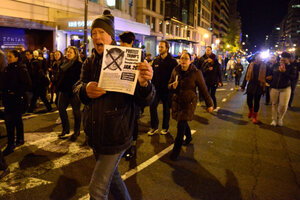Historic Inauguration Day protests? Organizers still waiting for permits
Groups planning to protest in Washington, D.C., around Inauguration Day are worried that they haven't received a permit yet, with some alleging a plot to quash dissent.

Demonstrators march against President-elect Donald Trump's election in downtown Washington, D.C., after leaving Lafayette Park, near the White House, on Nov. 12, 2016.
Mike Theiler/Reuters
After thousands of Americans took to the streets to protests against President-elect Donald Trump after the elections, more marches may be staged around Inauguration Day on Jan. 20, 2017 – provided they are given permits in time.
Several groups seeking to protest at the capital around the inauguration are concerned that they still have not received a permit from the National Park Service (NPS). The Partnership for Civil Justice Fund, a civil rights group that has previously litigated on behalf of Washington, D.C., protestors, alleged on Wednesday that the NPS is suppressing dissent by blocking access to public land.
In response to media inquiries, the NPS said they are still processing applications, and that doing so is not unusual in early December. The heightened tension in this year’s elections and the subsequent wave of protests, however, mean that there is more competition for space – between protesters, and with inauguration organizers – in the capital.
“This is always the way it happens,” Mike Litterst, a spokesman for NPS, told The Washington Post. “What makes this so complicated is that not only is this inauguration, but because there has been so much interest on both sides of this election, we are seeing all of these extra events that want to take place at the same time.”
The Presidential Inaugural Committee is historically given priority for certain areas around the White House, National Mall, Pennsylvania Avenue, Lincoln Memorial, and Washington Monument. Most public sidewalks along the parade route are open to protesters, Mr. Litterst told Reuters. Anyone who wants to organize a protest can submit an application to NPS free of charge.
The catch is that the inauguration committee has priority to the areas reserved by the NPS, which applies for permits on their behalf a year in advance. After the committee has mapped out their plans, whatever spots remain are available on a first-come-first-serve basis among protesters who file an application. So far, the Presidential Inaugural Committee has not finalized its plans for the inauguration, nor told NPS which permits it needs, according to The Washington Post, and they do not have a deadline to decide.
This complicates the plan for protesters who have to figure out where to gather and how far ahead of time to notify attendees traveling from out of state, with some concerned that the delay is a strategy to suppress dissent.
The ANSWER Coalition, represented by the Partnership for Civil Justice Fund, has threatened legal action against NPS if it does not allow protesters to use land in front of Trump International Hotel for demonstrations. The group had planned to demonstrate to fight racism and defend immigrants along Pennsylvania Avenue.
Among the largest groups planning to protest is the Women’s March on Washington, which is marching for human rights, particularly women's and minorities', the day after the inauguration. Their application for Lincoln Memorial was denied, and the group is now in discussion with NPS over alternatives.
“The short answer is we do not expect any problems based on our plans,” Cassady Fendlay, a spokeswoman for the group, tells The Christian Science Monitor in an email. “We are meeting with the permitting authorities today and will either hold a virtual press conference or put out a statement this afternoon.”
Two previous presidential inauguration ceremonies were punctuated with large-scale protests, both during Republican inaugurations. Richard Nixon’s ceremony was interrupted by shouts from anti-Vietnam war protesters in 1973 and George W. Bush was met with demonstrators unhappy with his victory after his opponent, Al Gore, won the popular vote, in 2001.
According to some estimates compiled by The New Yorker, President Nixon’s inauguration day saw about 60,000 protesters, whereas up to 20,000 showed up to protest against President Bush. The Women’s March so far has 228,000 people interested in attending, according to its Facebook page, and activists expect to see more protests by other groups.
Plenty of groups, however, have not been waiting for January to bring their post-election message to the streets.
“In other elections, the protesters would largely wait until Inauguration Day. To me, this is unprecedented in terms of what’s happening already,” Jim Bendat, the author of a book about the history of inaugurations, told The New Yorker.
This report contains material from the Associated Press.

